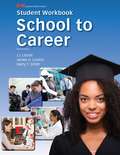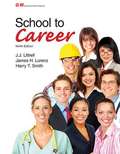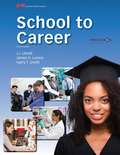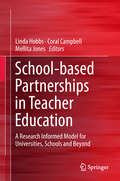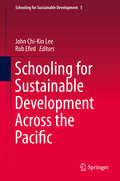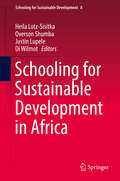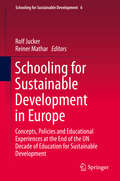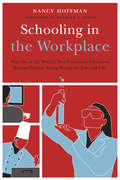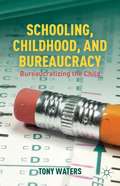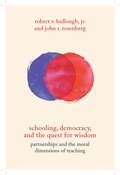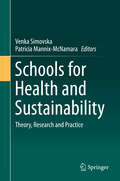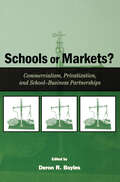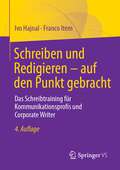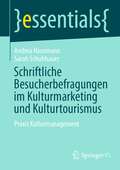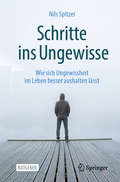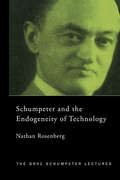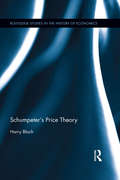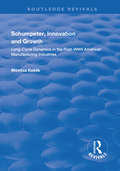- Table View
- List View
School Specialty, Inc.
by Stuart C. Gilson Kristin MugfordSet in 2013, School Specialty was a financially troubled supplier of educational products to primary and secondary schools in the United States. The company planned to file Chapter 11 in order to address its excessive debt load, but needed to arrange debtor-in-possession financing to provide liquidity while in bankruptcy. The company has received a financing proposal from its existing term loan lender that includes some aggressive and unusual features. This includes the requirement that, immediately upon filing for Chapter 11, School Specialty undertake to sell its assets under Section 363 of the U.S. Bankruptcy Code. The Company must decide whether to accept this proposal, and what other options may be available.
School Store Operations
by DecaSchool Store Operations turns a school store into a learning laboratory. <P><P>Developed in conjunction with DECA, this one-of-a-kind text presents the planning needed to develop and start a school store, as well as the business functions involved in its successful operation. <P><P>Career preparation is infused throughout the text, as students learn the skills and attitudes required in any job.
School To Career
by Harry T. Smith J. J. Littrell James H. Lorenz Ed. D.<P>This workbook is designed for use with the textbook School to Career. <P>As you complete the activities in this workbook, you will review the facts and concepts presented in the text. <P>The overall objective of these activities is to help you make a smooth transition from your classroom to a meaningful job in the workplace.<P> The activities will help you gain the skills you need to succeed in the workplace.<P> Some activities, such as crossword puzzles, true/false questions, and math exercises, have "right" answers. Other activities ask you to evaluate various situations, make comparisons, or draw your own conclusions.<P> These activities have neither "right" or "wrong" answers, as they are designed to stimulate creative thinking and help you develop ideas.
School of One: Reimagining How Students Learn (B)
by John J-H Kim Christine S. AnThis supplements the "A" case. Joel Rose and Chris Rush decide to spin-off from School of One to found New Classrooms Innovation Partners. Rose and Rush navigate the strategic complexities of the spin-off process to make their mission-driven product a reality. The case explores the co-founders' decision to pursue either a for-profit or nonprofit structure and their strategy for scaling their product, Teach to One.
School to Career
by Harry T. Smith J. J. Littrell James H. LorenzSchool to Career helps prepare students to achieve success in high school, college, career, and life. In this text, students are presented with information they need today to make career choices tomorrow. In order to prepare students for their future, twenty-first century life and career skills are introduced in the text as well as personal skills, decision-making skills, technology skills, and employability skills. Skills for success such as teamwork and problem solving, communicating on the job, and leadership are also covered. Opportunities are presented to research careers using the 16 national career clusters, as established by the States' Career Clusters Initiative, to help define future goals. As part of the learning process, students will assess graduation plans and explore college and other post-secondary programs that might help them reach their goals. College access and funding an education are also covered. School to Career is the first step for preparing for the challenges faced after graduation. By studying this text, students will be able to make the most of their study time and learn how to prepare for the future.
School-based Partnerships in Teacher Education: A Research Informed Model For Universities, Schools And Beyond
by Coral Campbell Mellita Jones Linda HobbsThis book demonstrates school-based approaches to primary science teacher education. The models used involve partnerships between universities and primary schools to engage pre-service primary teachers in classroom teaching and learning that effectively connects theory with practice separate to the formal practicum arrangements. The book is a culmination of the research and collaboration of researchers from five Australian universities involved in the Science Teacher Education Partnerships with Schools (STEPS) project, funded by the Australian Government Office for Learning and Teaching.While the STEPS project focused on partnerships in primary science teacher education, a key strength of the partnership model (the STEPS Interpretive Framework) developed and explored in this book is its applicability for cross-case, national, international, and inter-state analyses of partnership practices. This is shown through a number of case studies where the STEPS Interpretive Framework is applied and evaluated in the context of other school- or learning-related partnerships. These broad-ranging analyses illustrate the relevance of the model to a range of settings, both within and outside of education.
Schoolhouses, Courthouses, and Statehouses: Solving the Funding-Achievement Puzzle in America's Public Schools
by Eric A. Hanushek Alfred A. LindsethImproving public schools through performance-based fundingSpurred by court rulings requiring states to increase public-school funding, the United States now spends more per student on K-12 education than almost any other country. Yet American students still achieve less than their foreign counterparts, their performance has been flat for decades, millions of them are failing, and poor and minority students remain far behind their more advantaged peers. In this book, Eric Hanushek and Alfred Lindseth trace the history of reform efforts and conclude that the principal focus of both courts and legislatures on ever-increasing funding has done little to improve student achievement. Instead, Hanushek and Lindseth propose a new approach: a performance-based system that directly links funding to success in raising student achievement. This system would empower and motivate educators to make better, more cost-effective decisions about how to run their schools, ultimately leading to improved student performance. Hanushek and Lindseth have been important participants in the school funding debate for three decades. Here, they draw on their experience, as well as the best available research and data, to show why improving schools will require overhauling the way financing, incentives, and accountability work in public education.
Schooling for Sustainable Development Across the Pacific
by John Chi-Kin Lee Rob EfirdEnvironmental education (EE) and education for sustainable development (ESD) are asserting their growing role in curricula around the world, yet how deeply embedded are they in the learning systems of the Pacific nations? Building on an earlier analysis in China and Taiwan, this volume expands its purview to examine the quality and extent of environmental and sustainable development education in a number of countries in the Asia-Pacific region, including China itself, Taiwan, South Korea, Japan and Indonesia As well as offering detailed national analyses provided by Asian-Pacific academics and professionals, this work includes examples in the US and Canada and an introduction that assesses the contrasting challenges and positive commonalities among diverse education systems. The chapters reflect leading-edge practice, innovation, and depth of experience and at the same time as detailing locally relevant and culturally appropriate strategies they also provide clear models and strategies for expanding the application and influence of education for sustainable development elsewhere. In doing so, they mirror the global nature of environmental issues as well as the local nature of the solutions.
Schooling for Sustainable Development in Africa
by Heila Lotz-Sisitka Overson Shumba Justin Lupele Di WilmotThis book considers the scope and dynamics of Education for Sustainable Development (ESD) and learning in schools in Africa. It explores the conditions and processes that support such learning, and examines how ESD in schooling can improve the quality and relevance of education. The quality of education has been defined internationally as a key concern for educational institutions around the world, including schools in Africa. The models of quality are often limited to performance-based approaches and/or inclusive approaches. The contributions in this book show that there is more to a discussion on educational quality in Africa than performance success and/or inclusion. The chapters explain how ESD brings a new relevance to education in Africa, and at the same time, sounds the beginning of a new concept of quality education. The volume presents a collection of experiences in creating and supporting quality learning processes through a variety of ESD practices.
Schooling for Sustainable Development in Europe
by Rolf Jucker Reiner MatharThis book examines the implementation of Education for Sustainable Development (ESD) programs in schools across Europe. It describes and analyzes how individual countries and the region as a whole have established teaching and learning methods to help students develop the competencies needed to be part of a sustainable society. Featuring chapters written by experts throughout Europe, the book first provides a general overview of ESD in various contexts, including the state-of-the-art of ESD theory and conceptual development; political and social analysis; the various concepts of ESD competencies; and teacher training. Next, the book details how ESD has been implemented in different European countries and regions, including: Sweden, Italy, Germany, Austria, Switzerland, Catalonia, Hungary, Finland, Norway, Denmark, Flanders, France, Cyprus, UK and the Netherlands. In recognition of education as a motor of change, the United Nations General Assembly declared a Decade of Education for Sustainable Development (2005-2014), calling for the integration of sustainable development into all aspects of education and learning. Inside this book, readers will find details on what has been done, as well as assessments of what more could be done, across Europe. It will help readers gain valuable insights into how to help students develop the knowledge, skills and values needed to shape a sustainable future.
Schooling in the Workplace: How Six of the World's Best Vocational Education Systems Prepare Young People for Jobs and Life (Work and Learning Series)
by Nancy HoffmanWhich non-American education systems best prepare young people for fulfilling jobs and successful adult lives? And what can the United States—where far too many young people currently enter adulthood without adequate preparation for the twenty-first-century job market—learn, adopt, and adapt from these other systems? In Schooling in the Workplace, Nancy Hoffman addresses these questions head on, arguing that &“the smartest and quickest route to a wide variety of occupations for the majority of young people in the successful countries—not a default for failing students—is a vocational program that integrates work and learning.&” As she notes, the programs that successfully integrate work and learning all share a fundamental commitment to helping young people find successful careers: &“The purpose is not &‘college for all,&’ as in the United States today, but rather to provide the education and training young people need to prepare for a career or calling.&” Schooling in the Workplace explores the vocational education programs in a wide range of countries, focusing in rich and useful detail on six in particular: Australia, Austria, Germany, the Netherlands, Norway, and Switzerland. Framing these discussions, however, is a persistent focus on American circumstances and challenges. Far more than a survey of six &“foreign&” programs, this is a book prompted by and organized around the policy and practical challenges facing the United States.
Schooling, Childhood, and Bureaucracy
by Tony WatersIn exploring the relationship between bureaucratic schooling and the individual child, Waters describes the persistence of educational inequality, child development, and the nature of bureaucracy. The conclusions point out how education bureaucracies frame both schooling and childhood as they relentlessly seek to create ever more perfect children.
Schooling, Democracy, and the Quest for Wisdom: Partnerships and the Moral Dimensions of Teaching
by Robert V Bullough John R RosenbergIn response to growing concern in the 1980s about the quality of public education across the United States, a tremendous amount of energy was expended by organizations such as the Holmes Group and the Carnegie Forum to organize professional development schools (PDS) or “partner schools” for teacher education. On the surface, the concept of partnering is simple; however, the practice is very costly, complex, and difficult. In Schooling, Democracy, and the Quest for Wisdom, Robert V. Bullough, Jr. and John R. Rosenberg examine the concept of partnering through various lenses and they address what they think are the major issues that need to be, but rarely are, discussed by thousands of educators in the U.S. who are involved and invested in university-public school partnerships. Ultimately, they assert that the conversation around partnering needs re-centering (most especially on the purposes of public education), refreshing, and re-theorizing.
Schools for Health and Sustainability
by Venka Simovska Patricia Mannix McnamaraSchools are unique places. They pay a central role in the formation of young people. The importance of how young people are educated and how they are encouraged to live and learn cannot be underestimated. This book advocates for the fostering of agency not only amongst school personnel but also amongst younger generations for health and sustainability. It provides the reader with a new lens with which to discover health promoting schools and education for sustainable development. It invites the reader to look more deeply into both and to accompany the authors on a journey of discovery of the real potential for each to enhance the practice of schooling.
Schools or Markets?: Commercialism, Privatization, and School-business Partnerships
by Deron R. BoylesThis book challenges readers to consider the consequences of commercialism and business influences on and in schools. Critical essays examine the central theme of commercialism via a unique multiplicity of real-world examples. Topics include: *privatization of school food services;*oil company ads that act as educational policy statements;*a parent's view of his child's experiences in a school that encourages school-business partnerships;*commercialization and school administration; *teacher union involvement in the school-business partnership craze currently sweeping the nation;*links between education policy and the military-industrial complex;*commercialism in higher education, including marketing to high school students, intellectual property rights of professors and students, and the bind in which professional proprietary schools find themselves; and*the influence of conservative think tanks on information citizens receive, especially concerning educational issues and policy. Schools or Markets?: Commercialism, Privatization, and School-Business Partnerships is compelling reading for all researchers, faculty, students, and education professionals interested in the connections between public schools and private interests. The breadth and variety of topics addressed make it a uniquely relevant text for courses in social and cultural foundations of education, sociology of education, educational politics and policy, economics of education, philosophy of education, introduction to education, and cultural studies in education.
Schreiben in der Finanzwelt: Analysen, Methoden, Praxistipps
by Marlies WhitehouseDas Buch erfasst zuerst den komplexen und dynamischen Kontext, in dem Schreiben in der Finanzwelt geschieht, und untersucht dann am Beispiel einer zentralen Textsorte, was diese Textprodukte tatsächlich leisten. Schließlich entwickelt das Buch forschungsbasierte Werkzeuge, die den Kommunikationserfolg von Finanztexten systematisch und wirksam verbessern können.
Schreiben und Redigieren – auf den Punkt gebracht: Das Schreibtraining für Kommunikationsprofis und Corporate Writer
by Ivo Hajnal Franco ItemDas Buch bietet professionellen Schreiberinnen und Schreibern praxisnahe Anregungen, eigene wie fremde Texte zu optimieren. Ein professioneller Sprachgebrauch hält sich an klare, objektive Vorgaben. Dementsprechend beruht dieses Buch auf empirischen Daten zur Verständlichkeit von Unternehmens- und Medientexten, die in eine leicht umzusetzende Checkliste münden.
Schriftliche Besucherbefragungen im Kulturmarketing und Kulturtourismus: Praxis Kulturmanagement (essentials)
by Andrea Hausmann Sarah SchuhbauerDieses essential erläutert fundiert und kompakt die schriftliche Besucherbefragung als Instrument im Kulturmarketing und Kulturtourismus. Nach einer Einführung in die wichtigsten Begriffe werden die beiden Methoden schriftlicher Befragungen (Paper-Pencil und Online) anwendungsbezogen vorgestellt und auf ihre Stärken und Schwächen untersucht. Hierauf aufbauend werden die einzelnen Phasen von schriftlichen Befragungen – von der Gestaltung eines Fragebogens und der Datenerhebung über die Datenaufbereitung und -auswertung bis hin zur Follow-up-Phase – skizziert. Die theoretischen Erläuterungen werden anhand vieler aktueller Beispiele aus der Praxis von Kultur und Tourismus illustriert.
Schritt für Schritt ins Nachhaltigkeitsmanagement: Einstieg für Sozialwirtschaft, Freie Wohlfahrtspflege und Kirche
by Stefanie Oeben Inci WiedenhöferDieses Buch bietet eine Schritt-für-Schritt-Anleitung für Sozialwirtschaft, Freie Wohlfahrtspflege und Kirche, um Nachhaltigkeitsthemen und damit Zukunftsthemen zu identifizieren und implementieren. Denn der Einstieg in die Nachhaltigkeitsberichterstattung ist nicht nur die Entscheidung für eine transparente, sich ehrlich machende Organisation, sondern auch die Entscheidung dafür, strategische Zukunftsthemen bewusst anzugehen. Darüber hinaus spielen Nachhaltigkeitskriterien mittlerweile eine wichtige Rolle bei der Vergabe von Finanzmitteln und öffentlichen Aufträgen, so dass sich der Einstieg in die Nachhaltigkeitsberichterstattung auch direkt auf das operative Geschäft auswirkt. Doch womit zuerst beginnen? Die Autorinnen zeigen auf, wie unter Einbeziehung der relevanten Anspruchsgruppen ökonomische, ökologische und soziale Ziele identifiziert und strukturiert bearbeitet werden können. Mit praktischen Tipps und Themenlisten, die auf die speziellen Bedürfnisse von Sozialwirtschaft,Freie Wohlfahrtspflege und Kirche zugeschnitten sind, lotsen die Autorinnen durch die einzelnen Stufen, die auf dem Weg zu einer systematischen und fundierten Berichterstattung nach dem anerkannten Standard des Deutschen Nachhaltigkeitskodexes (DNK) zu nehmen sind.
Schritt für Schritt zum Patent
by Sonja VorwerkDieses Buch vermittelt einen Überblick über den Prozess der Patenterteilung und zeigt auf, dass Patente auf Erfindungen auch im Interesse der Wissenschaftler sind und dass ihnen eine zunehmend wichtigere Rolle in der Bewertung wissenschaftlicher Arbeit zukommt. Es wendet sich an alle, die auf dem Gebiet der Patente noch Wissenslücken haben und legt auf verständliche Weise dar, dass sich Patente und wissenschaftliche Publikationen nicht ausschließen müssen. Patente bieten die Chance auf eine weitere Einnahmequelle (Arbeitnehmererfindervergütung) und können sogar die Grundlage für ein Spin-Off und somit eine eigene Unternehmens(mit)gründung sein. Dieses Werk bietet einen Leitfaden, um sich im komplizierten Prozess der Patenterteilung zurechtzufinden und ermöglicht so dem Leser, für seine eigene Patentanmeldung effektiv mit dem Patentfachmann zusammenzuarbeiten.
Schritte ins Ungewisse: Wie sich Ungewissheit im Leben besser aushalten lässt
by Nils SpitzerUngewissheit ist überall, im Kleinen wie im Großen: Ist das Licht im Kühlschrank wirklich aus? Wird der Zeitarbeitsvertrag verlängert? Wird es im Urlaub regnen? Wie wird sich die chronische Krankheit weiterentwickeln? Dieser Ratgeber zeigt, wie eine geringe Toleranz gegenüber Ungewissheiten Menschen belasten kann, gerade wenn sich solche Ungewissheiten ballen. Er zeigt Methoden, die eigene Ungewissheitstoleranz zu erhöhen, um hier besser gewappnet zu sein.Die Reihe der psychischen Probleme, mit denen eine geringe Ungewissheitstoleranz in Zusammenhang gebracht wird, verlängert sich immer mehr: Depression, Ess- und Zwangsstörung, Autismus, aber auch der Umgang mit ungewissen körperlichen Erkrankungen wie Krebs oder MS. Dieser Ratgeber zeigt das schwierige gesellschaftliche Zusammenspiel von neuen Freiheiten und Ungewissheiten – er bietet Möglichkeiten, einen besseren Umgang mit dem Ungewissen zu finden. Vorgestellt werden zudem drei hilfreiche Haltungen, Ungewissheit nicht bloß gut auszuhalten: das Ungewisse (1) als Genuss oder (2) als Abenteuer nehmen lernen oder (3) ihm mit Resonanz begegnen.Geschrieben für …Betroffene und Interessierte; Psychologische Psychotherapeuten, Psychiater, Berater können das Buch therapie- und beratungsbegleitend empfehlen.Der Autor:Dipl.-Psych. Nils Spitzer ist Psychologischer Psychotherapeut mit eigener Praxis. Er schreibt Bücher und Zeitschriftenbeiträge und ist Dozent in Psychotherapieausbildungen wie auf Fachkongressen.
Schumpeter and the Endogeneity of Technology: Some American Perspectives (The\graz Schumpeter Lectures #No.2)
by Nathan RosenbergSchumpeter's profoundly influential work developed the notion of the endogeneity of technology, and offered illuminating historical analyses of how and why some social systems have managed to generate innovation. This new interpretation explores Schumpeter's central ideas, and examines the ways in which the concept of endogeneity can illuminate rec
Schumpeter's Price Theory (Routledge Studies in the History of Economics)
by Harry BlochJoseph Alois Schumpeter has long been recognised as one of the great economists of the 20th Century, and his truly revolutionary approach to economic development continues to gain appreciation. This is particularly due to the emphasis he places on innovation and creative destruction as drivers of economic development. Yet, aspects of his theory remain neglected and poorly understood, especially his treatment of prices and price dynamics. This book provides a comprehensive and critical examination of Schumpeter’s price theory as well as providing suggestions for the further development of the theory. While Schumpeter’s theories of economic development, entrepreneurship and the business cycle have received substantial attention in the literature, his price theory has been neglected. Yet, he proposes a price theory that is as radical as his treatment of other topics. The holistic nature of his theory also naturally means that a better understanding of his price theory will provide extra insight into other aspects of his theoretical framework. This volume is of great interest to those who study Schumpeter’s work, as well as those who have an interest in history of economic thought, economic theory and philosophy and political economy.
Schumpeter, Innovation and Growth: Long-Cycle Dynamics in the Post-WWII American Manufacturing Industries
by Mümtaz KeklikThis title was first published in 2003. Bringing together contemporary innovation pattern theories inspired by the two original patterns developed by Joseph A. Schumpeter, this book develops an innovative new model of long wave aggregate level economic activity. This model is rigorously tested with post-war US manufacturing data, revealing an intriguing correlation between the data and the model. The book examines different theories of technological change, and provides a detailed account of the long wave which makes use of the relevant aspects of these theories, without betraying their main features and messages. These theories are synthesized and shown to be consistent with the development of post-war US manufacturing. Shedding light on the dynamics of the technological advances that have taken place in the last 20 years, economists and students alike will find this volume an invaluable read.


